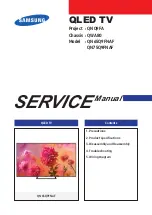
4
13. Outdoor Antenna Grounding
If an outside antenna or cable system is connected to the TV be sure the antenna or cable system is ground-
ed so as to provide some protection against voltage surges and built up static charges. Article 810 of the
National Electrical Code (U.S.A.), ANSI / NFPA 70 provides information with regard to proper grounding
of the mast and supporting structure, grounding of the lead-in wire to an antenna discharge unit, size of
grounding conductors, location of antenna-discharge unit, connect on to grounding electrodes, and require-
ments for the grounding electrode.
Example of Grounding According to National
Electrical Code Instructions
Antenna Lead in Wire
Grounding Conductor
(NEC Section 810-21)
Ground Clamps
Power Service Grounding
Electrode System (NEC
Art 250, Part H)
11. Power-Cord Protection
Power-supply cords should be routed so that they are not likely to be walked on or pinched by items placed
upon or against them, paying particular attention to cords at plugs,convenience receptacles, and the point
where they exit from the TV.
12. Lightning
For added protection for the TV during a lightning storm, or when it is left unattended and unused for long
periods of time,unplug it from the wall outlet and disconnect the antenna or cable system. This will prevent
damage to the TV from lightning and power-line surges.
NEC - National Electrical Code
14. Power Lines
An outside antenna system should not be located in the vicinity of overhead power lines or other electric
light or power circuits, or where it can fall on to power lines or circuits. When installing an outside antenna
system, extreme care should be taken to keep from touching such power lines or circuits as contact with
them might be fatal.
15. Overloading
'RQRWRYHUORDGZDOORXWOHWVDQGH[WHQVLRQFRUGVDVWKLVFDQUHVXOWLQDULVNRI¿UHRUHOHFWULFVKRFN
Antenna Discharge Unit
(NEC Section 810-20)
Ground Clamp
Electric Service
Equipment
Important Safety Information
1
















































